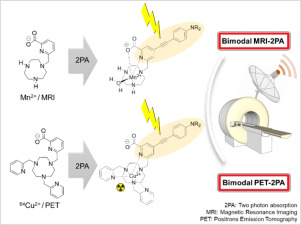当前位置:
X-MOL 学术
›
J. Inorg. Biochem.
›
论文详情
Our official English website, www.x-mol.net, welcomes your feedback! (Note: you will need to create a separate account there.)
Picolinate-appended tacn complexes for bimodal imaging: Radiolabeling, relaxivity, photophysical and electrochemical studies.
Journal of Inorganic Biochemistry ( IF 3.9 ) Pub Date : 2019-12-28 , DOI: 10.1016/j.jinorgbio.2019.110978 Amaury Guillou 1 , Margaux Galland 2 , Amandine Roux 2 , Balázs Váradi 3 , Réka Anna Gogolák 3 , Patricia Le Saëc 4 , Alain Faivre-Chauvet 4 , Maryline Beyler 1 , Christophe Bucher 2 , Gyula Tircsó 3 , Véronique Patinec 1 , Olivier Maury 2 , Raphaël Tripier 1
Journal of Inorganic Biochemistry ( IF 3.9 ) Pub Date : 2019-12-28 , DOI: 10.1016/j.jinorgbio.2019.110978 Amaury Guillou 1 , Margaux Galland 2 , Amandine Roux 2 , Balázs Váradi 3 , Réka Anna Gogolák 3 , Patricia Le Saëc 4 , Alain Faivre-Chauvet 4 , Maryline Beyler 1 , Christophe Bucher 2 , Gyula Tircsó 3 , Véronique Patinec 1 , Olivier Maury 2 , Raphaël Tripier 1
Affiliation

|
Based on our previous works involving two 1,4,7-triazacyclononane (tacn)-based ligands Hno2py1pa (1-Picolinic acid-4,7-bis(pyridin-2-ylmethyl)-1,4,7-triazacyclononane) and Hno1pa (1-Picolinic acid-1,4,7-triazacyclononane), we report here the synthesis of analogues bearing picolinate-based π-conjugated ILCT (Intra-Ligand Charge Transfer) transition antenna (HL1, HL2), using regiospecific N-functionalization of the tacn skeleton and their related transition metal complexes (e.g. Cu2+, Zn2+ and Mn2+). Coordination properties as well as their photophysical and electrochemical properties were investigated in order to quantify the impact of such antenna on the luminescent or relaxometric properties of the complexes. The spectroscopic properties of the targeted ligands and metal complexes have been studied using UV-Vis absorption and fluorescence spectrocopies. While the zinc complex formed with HL1 possesses a moderate quantum yield of 5%, complexation of Cu2+ led to an extinction of the luminescence putatively attributed to a photo-induced electron transfer, as supported by spectroscopic and electrochemical evidences. The [Mn(L2)]+ complex is characterized by a fluorescence quantum yield close to 8% in CH2Cl2. The potential interest of such systems as bimodal probes has been assessed from radiolabeling experiments conducted on HL1 and 64Cu2+ as well as confocal microscopy analyses and from relaxometric studies carried out on the cationic [Mn(L2)]+ complex. These results showed that HL1 can be used for radiolabeling, with a radiochemical conversion of 40% in 15 min at 100 °C. Finally, the relaxivity values obtained for [Mn(L2)]+, r1p = 4.80 mM-1·s-1 and r2p = 8.72 mM-1·s-1, make the Mn(II) complex an ideal candidate as a probe for Magnetic Resonance Imaging.
中文翻译:

用于双峰成像的吡啶甲酸-tacn配合物:放射标记,弛豫,光物理和电化学研究。
基于我们之前的工作,涉及两个基于1,4,7-三氮杂壬烷(tacn)的配体Hno2py1pa(1-吡啶甲酸-4,7-双(吡啶-2-基甲基)-1,4,7-三氮杂壬烷)和Hno1pa (1-Picolinic acid-1,4,7-triazacyclononane),我们在这里报告使用区域特异性N-官能化合成带有基于吡啶甲酸的π共轭ILCT(配体内电荷转移)过渡天线(HL1,HL2)的类似物Tacn骨架及其相关的过渡金属配合物(例如Cu2 +,Zn2 +和Mn2 +)的结构。研究了配位性质以及它们的光物理和电化学性质,以便量化这种天线对配合物的发光或弛豫性质的影响。使用UV-Vis吸收和荧光光谱学研究了目标配体和金属络合物的光谱性质。虽然由HL1形成的锌络合物具有5%的适度量子产率,但光谱和电化学证据支持,Cu2 +的络合物导致归因于光诱导电子转移的发光消失。[Mn(L2)] +络合物的特征是在CH2Cl2中的荧光量子产率接近8%。通过在HL1和64Cu2 +上进行的放射性标记实验以及共聚焦显微镜分析以及在阳离子[Mn(L2)] +络合物上进行的弛豫研究,已评估了这类系统(如双峰探针)的潜在兴趣。这些结果表明HL1可用于放射性标记,在100°C下15分钟内的放射化学转化率为40%。最后,[Mn(L2)] +,r1p = 4.80 mM-1·s-1和r2p = 8.72 mM-1·s-1的弛豫值使Mn(II)配合物成为理想的探针用于磁共振成像。
更新日期:2019-12-29
中文翻译:

用于双峰成像的吡啶甲酸-tacn配合物:放射标记,弛豫,光物理和电化学研究。
基于我们之前的工作,涉及两个基于1,4,7-三氮杂壬烷(tacn)的配体Hno2py1pa(1-吡啶甲酸-4,7-双(吡啶-2-基甲基)-1,4,7-三氮杂壬烷)和Hno1pa (1-Picolinic acid-1,4,7-triazacyclononane),我们在这里报告使用区域特异性N-官能化合成带有基于吡啶甲酸的π共轭ILCT(配体内电荷转移)过渡天线(HL1,HL2)的类似物Tacn骨架及其相关的过渡金属配合物(例如Cu2 +,Zn2 +和Mn2 +)的结构。研究了配位性质以及它们的光物理和电化学性质,以便量化这种天线对配合物的发光或弛豫性质的影响。使用UV-Vis吸收和荧光光谱学研究了目标配体和金属络合物的光谱性质。虽然由HL1形成的锌络合物具有5%的适度量子产率,但光谱和电化学证据支持,Cu2 +的络合物导致归因于光诱导电子转移的发光消失。[Mn(L2)] +络合物的特征是在CH2Cl2中的荧光量子产率接近8%。通过在HL1和64Cu2 +上进行的放射性标记实验以及共聚焦显微镜分析以及在阳离子[Mn(L2)] +络合物上进行的弛豫研究,已评估了这类系统(如双峰探针)的潜在兴趣。这些结果表明HL1可用于放射性标记,在100°C下15分钟内的放射化学转化率为40%。最后,[Mn(L2)] +,r1p = 4.80 mM-1·s-1和r2p = 8.72 mM-1·s-1的弛豫值使Mn(II)配合物成为理想的探针用于磁共振成像。



























 京公网安备 11010802027423号
京公网安备 11010802027423号